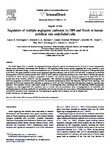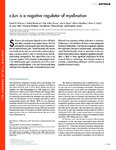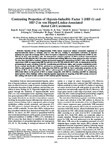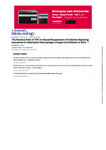Regulation of multiple angiogenic pathways by Dll4 and Notch in human umbilical vein endothelial cells.

Date
2008-03Author
Subject
Metadata
Show full item recordAbstract
The Notch ligand, Dll4, is essential for angiogenesis during embryonic vascular development and is involved in tumour angiogenesis. Several recent publications demonstrated that blockade of Dll4 signalling inhibits tumour growth, suggesting that it may constitute a good candidate for anti-cancer therapy. In order to understand the role of Dll4 at the cellular level, we performed an analysis of Dll4-regulated genes in HUVECs. The genes identified included several angiogenic signalling pathways, such as VEGF, FGF and HGF. In particular we identified downregulation (VEGFR2, placenta growth factor PlGF) of VEGF pathway components resulting in the overall effect of limiting the response of HUVEC to VEGF. However extensive upregulation of VEGFR1 was observed allowing continued response to its ligand PlGF but the soluble form of the VEGFR1, sVEGFR1 was also upregulated. PlGF enhanced tubulogenesis of HUVEC suggesting that downregulation of PlGF and upregulation of VEGFR1 including sVEGFR1 are important mechanisms by which Dll4 attenuates PlGF and VEGF signalling. Dll4-stimulated HUVECs had impaired ERK activation in response to VEGF and HGF indicating that Dll4 signalling negatively regulates these pathways. Dll4 expression reduced vessel sprout length in a 3D tubulogenesis assay confirming that Dll4 signalling inhibits angiogenesis. Altogether, our data suggest that Dll4 expression acts as a switch from the proliferative phase of angiogenesis to the maturation and stabilisation phase by blocking endothelial cell proliferation and allowing induction of a more mature, differentiated phenotype. The regulation of sVEGFR1 provides a novel mechanism for Dll4 signalling to regulate cells at distance, not just in adjacent cells.
Collections
Place of Publication
Journal
Volume
Issue
Pagination
Author URL
Recommended, similar items
The following license files are associated with this item:
Related items
Showing items related by title, author, creator and subject.
-
c-Jun is a negative regulator of myelination
Parkinson, DB; Bhaskaran, A; Arthur-Farraj, P; Noon, LA; Woodhoo, A; Lloyd, AC; Feltri, ML; Wrabetz, L; Behrens, A; Mirsky, R; Jessen, KR (Rockefeller University PressUnited States, 2008-05-19)<jats:p>Schwann cell myelination depends on Krox-20/Egr2 and other promyelin transcription factors that are activated by axonal signals and control the generation of myelin-forming cells. Myelin-forming cells remain ... -
Contrasting properties of hypoxia-inducible factor 1 (HIF-1) and HIF-2 in von Hippel-Lindau-associated renal cell carcinoma.
Raval, RR; Lau, KW; Tran, MGB; Sowter, HM; Mandriota, SJ; Li, J-L; Pugh, CW; Maxwell, PH; Harris, AL; Ratcliffe, PJ (United States, 2005-07)Defective function of the von Hippel-Lindau (VHL) tumor suppressor ablates proteolytic regulation of hypoxia-inducible factor alpha subunits (HIF-1alpha and HIF-2alpha), leading to constitutive activation of hypoxia ... -
The Possible Role of TGF-β-Induced Suppressors of Cytokine Signaling Expression in Osteoclast/Macrophage Lineage Commitment In Vitro.
Fox, Simon; Haque, LJ; Lovibond, AJ; Chambers, TJ (The American Association of ImmunologistsUnited States, 2003-04-01)<jats:title>Abstract</jats:title> <jats:p>Osteoclast formation is dependent on the ability of TGF-β to enable receptor activator of NF-κB ligand (RANKL)-induced commitment of hemopoietic precursors to the ...




